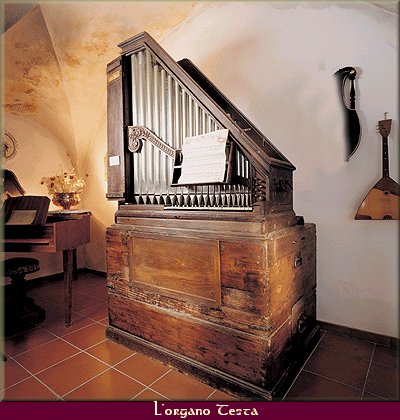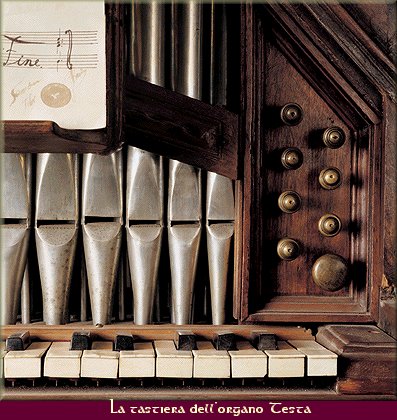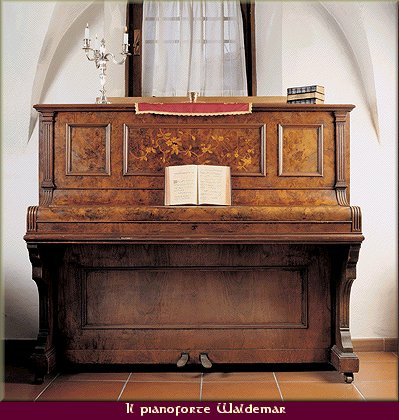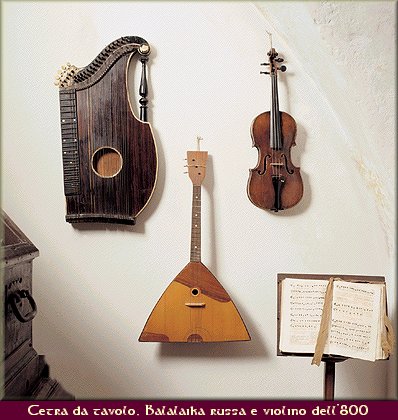|
The "Mozartina" The room of Testa organ |
![]()
![]() The House
The
Sala Carnica
The House
The
Sala Carnica
The Composer's Room
The room
of Genovesino
![]()
|
All the instruments, in this beautiful room with sail shaped vaults, are very significant for the collection. It is a synthesis of all the keyboard instruments. We can find an organ, an harpsichord, a piano with fort? mechanism, a piano with mechanics "a baionetta" and the instrument that first, in the history of music, was provided with a reed: the harmonic flute. The most important instrument is the Testa organ, that can be roughly dated back to 1650. This instrument is also defined "winged" because the arrangement of double-front pipes reminds the two closed wings of a bird. |
|
|
This instrument is a positivo-portable organ, provided with handles and decomposable. The appellative "positivo" is due to the fact that when it is put to place (positus) it has a weight that makes it irremovable. It is also said "portable" because it can be taken to pieces and be easily carried away. This kind of instrument is extremely handy in comparison with the big organs of its same age. The main characteristic of the instrument is to be a masterpiece of organ engineering, since in a space of little less than one square meter there can get crowded no fewer than 320 pipes. This is even more significative if you think that theoretically all these pipes, stealing each other the air, should not be even able to utter a sound. The ability of the organ-maker in manufacturing it has been that of balancing the length of the foot with the height of the various mouths, so that the instrument has nothing to lose in comparison with its bigger fellow organs. |
|
|
Another feature is the precision in manufacturing the 320 channels, each one with a diameter of two square centimeters, carved in one piece of walnut wood and covered by a slab, this too of walnut, two millimiters thick that distributes the air into the pipes. The instrument is well preserved, only a few pipes, easy to be spotted, have been remade. The pipes are made by an alloy tin at 88%, those in front have a very short foot. The instrument has a sound particularly soft due to the diameter of the pipes and, playing on the beatings of the octave with the main (which is of broad intonation) it is also possible to obtain the fife, i.e. the human voice. The organ-maker, of Neapolitan origin, who manufactured this instrument in 1650, wanted to give to some of the registers the brilliant and lively spirit typical of the Parthenopean school, where the fast rythms of saltarello and tarantella distingushed not only the secular music but also the sacred one. |
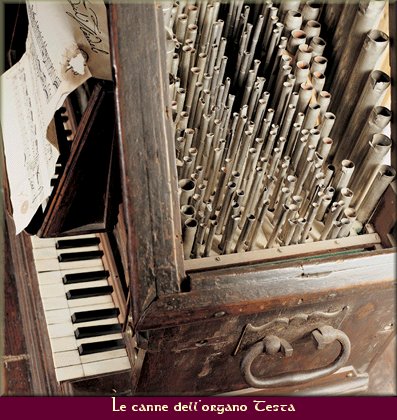 |
|
The keyboard, with the first octave short, has fortyfive keys, so this organ is suitable for Italian music (Bach can be played only with some acrobatics in the lower part of the keyboard where are absent the do# re# fa# sol# of the first octave). The keyboard then is very hard to play because the keys are very short and they are suspended from parchment foils. At present the instrument is feed by an electric fan, but it still has its original bellows, perfectly working, that were in the past set in motion by a bellows-operator standing at is side. The instrument belonged to the organ-maker Corrado Moretti, who was also the author of the best book on organ art we have in Italy. It is said that this organ, found by Moretti during his research trips to Rome, belonged to Queen Christine of Sweden who presented it to the cardinal Pietro Ottoboni, who became later pope Alexander VIII. It is also said that during a party in the house of Pietro Ottoboni there was a memorable competition between Georg Friedrich Hšendel and Domenico Scarlatti in 1708. |
|
|
In this room there is also on display the instrument that is closest to our days: the Thurmer piano, also characterized by particular histories. This piano, apart from the elegance of the furniture, is also interesting for its beautiful sound. It is an instrument of the end ?00 but with modern conception, mechanics corteza and framing made by suspended cast iron, the extraordinary purity of sound is due to the sound box still intact. The carvings on the wood depict zoological figures concerning the mysterious symbols of Freemasonry: the devil and the owl. Probably the Thurmers, being German people, were following the philanthropic spirit that with Joseph II was spreading in that period. This instrument is important because is one of the few still preserving the original structure. Ascolta il pianoforte Thurmer (160 Kb)
|
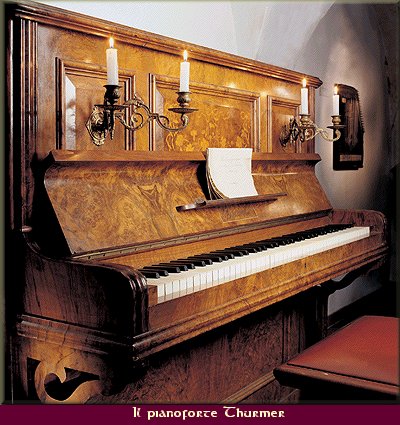 |
|
The harmonic flute invented by Greniť in 1810 is the first barrel organ with reed, and in comparison with pluck instruments, it is similar to the harpsicord. This is an important instrument (from which the great plays of Mustel and Debain were born) and it marks a decisive turning point because not only it produces autonomously the air needed by the pipes but, thanks to its small dimensions, it can only put in the house. Listen to the harmonic flute (300 Kb)
|
|
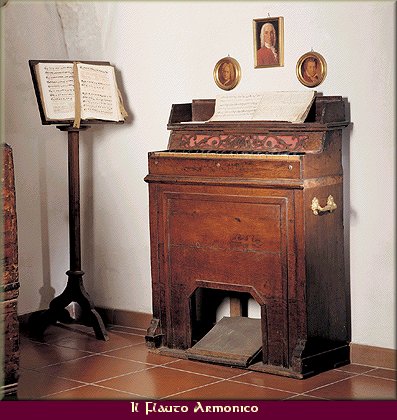 |
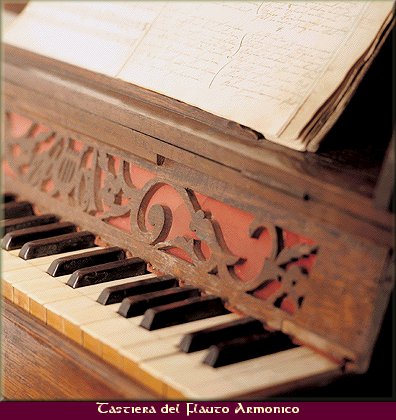 |
|
The Waldemar piano is an instrument of quite the same age as the Thurmer, but it has a different construction principle, since its bayonet mechanics, i.e. the sound lowering, is operated by the aid of counterweights. This difference led, in the nineteenth-century, to a conflict between manufacturers and piano teachers. The quality of sound is similar to Thurmer's, and this instrument too has the harmonic board still intact. |
|
|
Last the Ammer harpsichord with two sound levels: the strings of the first register are eight feet long, those of the second one only four feet. When the two registers are simultaneously playing, the timbre, in the fusion of the harmonics, recalls the sound of an organ. Listen to the Ammer harpsichord (410 Kb)
|
|
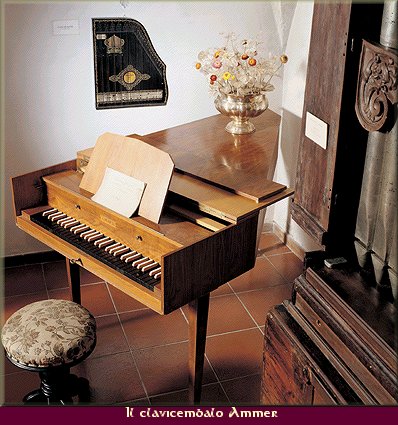 |
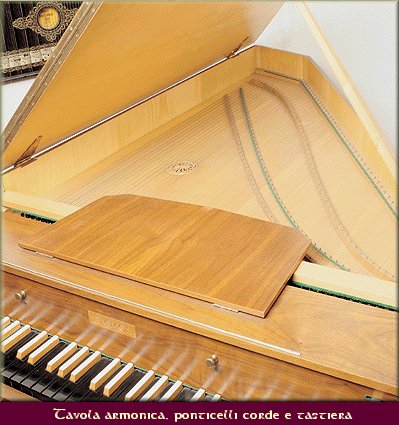 |
|
In the walls there are some table zithers similar to a guitar, they were mostly used to accompany the singers.
|
|

